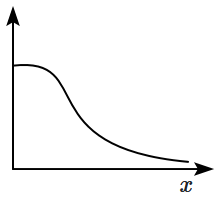
1. \(-MgR\)
2. \(-mgR\)
3. \(\dfrac{-MgR}{\sqrt2}\)
4. \(\dfrac{-mgR}{\sqrt2}\)

To unlock all the explanations of this course, you need to be enrolled.

To unlock all the explanations of this course, you need to be enrolled.
| Column I Charge distribution |
Column II Interaction energy |
||
| \(\mathrm{(A)}\) |  Two point charges separated by distance \(x\) |
\(\mathrm{(I)}\) |  |
| \(\mathrm{(B)}\) |  Interaction energy of a point charge with a uniformly charged spherical surface |
\(\mathrm{(II)}\) |  |
| \(\mathrm{(C)}\) |  Interaction energy of a point charge with a uniform spherical volume charge |
\(\mathrm{(III)}\) |  |
| \(\mathrm{(D)}\) |  Interaction energy of a dipole & a point charge |
\(\mathrm{(IV)}\) |  |
| 1. | \(\mathrm{A\text-II,B\text-I,C\text-IV,D\text-II}\) |
| 2. | \(\mathrm{A\text-II,B\text-IV,C\text-II,D\text-III}\) |
| 3. | \(\mathrm{A\text-II,B\text-II,C\text-II,D\text-IV}\) |
| 4. | \(\mathrm{A\text-II,B\text-IV,C\text-I,D\text-III}\) |

To unlock all the explanations of this course, you need to be enrolled.

To unlock all the explanations of this course, you need to be enrolled.
| 1. | \(Q_0V_0\) | 2. | \(\dfrac{Q_0V_0}{2}\) |
| 3. | \(\dfrac{Q_0V_0}{4}\) | 4. | \(-Q_0V_0\) |

To unlock all the explanations of this course, you need to be enrolled.

To unlock all the explanations of this course, you need to be enrolled.
| 1. | \(k.\dfrac{4q^2}{a}\) | 2. | \(k.\dfrac{4\sqrt2q^2}{a}\) |
| 3. | \(k.\dfrac{4q^2}{a\sqrt2}\) | 4. | zero |

To unlock all the explanations of this course, you need to be enrolled.

To unlock all the explanations of this course, you need to be enrolled.
| 1. | \(\dfrac{mgH}{q}\) | 2. | \(\dfrac{2mgH}{q}\) |
| 3. | \(\dfrac{mgH}{2q}\) | 4. | zero |

To unlock all the explanations of this course, you need to be enrolled.

To unlock all the explanations of this course, you need to be enrolled.

| 1. | \(q\) | 2. | \(\Large\frac{q}{2}\) |
| 3. | \(2q\) | 4. | \(4q\) |

To unlock all the explanations of this course, you need to be enrolled.

To unlock all the explanations of this course, you need to be enrolled.
| 1. | \(k{\Large\frac{qQ}{R}}\) | 2. | \(k{\Large\frac{qQ}{2\pi R}}\) |
| 3. | \(k{\Large\frac{\pi qQ}{R}}\) | 4. | zero |

To unlock all the explanations of this course, you need to be enrolled.

To unlock all the explanations of this course, you need to be enrolled.

1. zero
2. \(\Large\frac{kqQ}{3R}\)
3. \(\Large\frac{2kqQ}{3R}\)
4. none of the above

To unlock all the explanations of this course, you need to be enrolled.

To unlock all the explanations of this course, you need to be enrolled.




